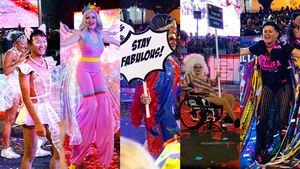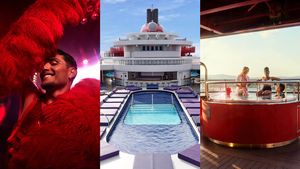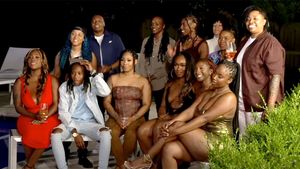As part of "Pacific Standard Time," an epic survey initiated by the Getty Foundation of postwar works that created and defined Los Angeles's potent modern art scene, comes a not-to-be-missed collection of seminal art, "Cruising the Archive: Queer Art and Culture in Los Angeles, 1945-1980."
Funded in part with a $50,000 grant from the Andy Warhol Foundation and curated from the gargantuan collection of the One National Gay and Lesbian Archives, this eclectic, poignant, and most often whimsical exhibition is spread over three venues.
"Wink Wink," in One's West Hollywood gallery, is a tasty tease of sexy paintings, wickedly sinful and potently political videos, plenty of penis on paper, and many sweet lesbian portraits. A brilliant black-and-white Steven Arnold photograph and a Cyclona pink-painted drag queen are two showstoppers, and Don Bachardy's giant phosphorescent acrylic of Keith Coleman is another treat to behold.
"Rare Looks," a companion show, has been mounted at One's downtown University of Southern California venue, its main archives, library, and offices. This show, with many smaller works on paper, also looks at gay and lesbian Los Angeles art of the mid-to-late 20th century and includes some artifacts as well.
The third and final show in One's troika, "Queer Worldmaking," opens this month at the Doheny Memorial Library at USC and will be made up largely of documents, photographs, and ephemera, including local gay publications, stage costumes, and Radical Faerie masks. There will be some related public programs, including a conversation with artist Don Bachardy March 27. A brilliant painter, Bachardy struggled for 20 years to emerge from the shadow of his world-famous lover, the writer Christopher Isherwood, and become known for his masterful portraiture.
"Wink Wink" will run through April 1 and the other shows until the end of May.
My favorite work in "Cruising the Archive" is John Quitman's Homage to Jean Genet, part of "Wink Wink." A beefy 49-by-61-inch canvas, painted in 1971, Homage is a deliciously madcap, surreal painting with enough fanciful phallus under skirt, pert and painterly nipples, and ample arse to please any irreverent purveyor of gay or lesbian art. The reference to Genet, an intellectual touchstone of that era, and the bawdiness and playfulness of the painting seem to embody the delightful nature of the entire show.
David Frantz, who curated "Cruising the Archive" along with Mia Locks, says, "I hope that visitors to the exhibition are intrigued by the materials on view, and possibly even interested in learning more. 'Cruising the Archive' was intended ... as a springboard ... a public engagement with the archives' vast collections."
I have often wondered, just how vast is One's vast hoard? According to treasurer and financial adviser Carol A. Grosvenor, One, the largest collection of LGBT materials in the world, has 4,000 works of art; 3,000 posters; 2,200 films; 500,000 photographs; 23,000 books (of which 3,000 are rare or one-of-a kind titles), and hundreds of thousands of files of ephemera. "Cruising the Archive" offers a rare, breathtaking peek at One's holdings
Frantz notes, "Whenever possible we wanted ... to present artworks alongside archival materials from the social or historical context of their production, artworks in dialogue with the larger archival collections at One."
Sidney Bronstein's sweet-sexy paintings of servicemen, which correspond to the artist's personal "sex log" from the 1950s, are a perfect example of this contextualization and evoke the very special times chronicled in "Pacific Standard Time."
"Pacific Standard Time" is the largest exhibition ever mounted by the Getty, which has partnered with more than 60 museums and galleries in Southern California to stage the ambitious project.
I ask Frantz about the Getty's "Pacific Standard Time" premise -- that the era from 1945 to 1980 established a new vision, a bold imprint, and a new genre, that being Los Angeles modern art. I wonder how Frantz saw that reflected in the works and artists he chose to include in One's show.
"The artworks and archival materials included in 'Cruising the Archive' shed new light on a period understudied in queer history," he says. "Los Angeles has an incredibly rich history of queer community ... dating back to the 1940s and even earlier, and we really wanted to pay tribute to these artists and activists, many of whom have received little or no attention for their work."
Many of the artists featured are unknown. Some better-known ones, like Don Bachardy, identify first as artists rather than as gay. Bachardy, who grew up in the city's Atwater Village neighborhood, tells me that back in the day, he knew gays who painted, but he was more interested in good painting, in the work itself, than in the minority that the work or painter belonged to.
The show, however, evokes a state of mind, a gay consciousness of the era, even when the creators are straight or non-Angelenos. Two highly evocative black-and-white photographs were shot by Anthony Friedkin, a heterosexual photographer. His work, what I call "historical humanism," charts a singular emotional through line of everyone he shoots, no matter what subculture they are from. A California original, Friedkin witnesses gay history with an instinctive intelligence, embodying a deep respect and understanding of our lives. He renders the subjects of his portraits with emotion, dignity, and a fond admiration for their humanity, in this case gay and lesbian humanity. And Anne Stockwell's boldly butch Self-portrait, painted in 1978, was created in Louisiana. (Stockwell, now a Los Angeles resident, is a former Advocate editor.)
So now all this great queer art is out of One's archival closets, selected from its vast, vast hoard. Out in the light for a few months. One's exhibition is a rare chance for everyone who comes to Los Angeles to enjoy. Don't wait to go. This is One amazing show.
For those who cannot make the trip to Los Angeles, the One Archives has published an opulent catalog of the show -- 208 pages of queer art from back in the day. The 9-by-11-inch book is wrapped in a blowup of Bob Damron's The Address Book with Bob's name discreetly left off the cover. Publishers of these types of materials once hid their names. They were often subject to obscenity arrests.
Inside the dust jacket is a specially commissioned collage by Onya Hogan-Finlay. Already collectible, the catalog's first edition is fast selling out. (I bought eight copies. Yes, I confess, I am a hoarder too). I will wait for the printing of the second edition to fill my Christmas gift list.
Purchasing a unique art book like this is also a way of helping the archive out. It is my hope that funds can be raised so that the exhibition can tour the country and that the One National Gay and Lesbian Archives can stage other shows and film screenings to let the world see more of its treasures.
The Cruising the Archive: Queer Art and Culture in Los Angeles, 1945-1980 catalog can be purchased from One's website for $37.50,which includes tax and shipping. For show and lecture information, and catalog sales, visit https://www.onearchives.org/


















































































